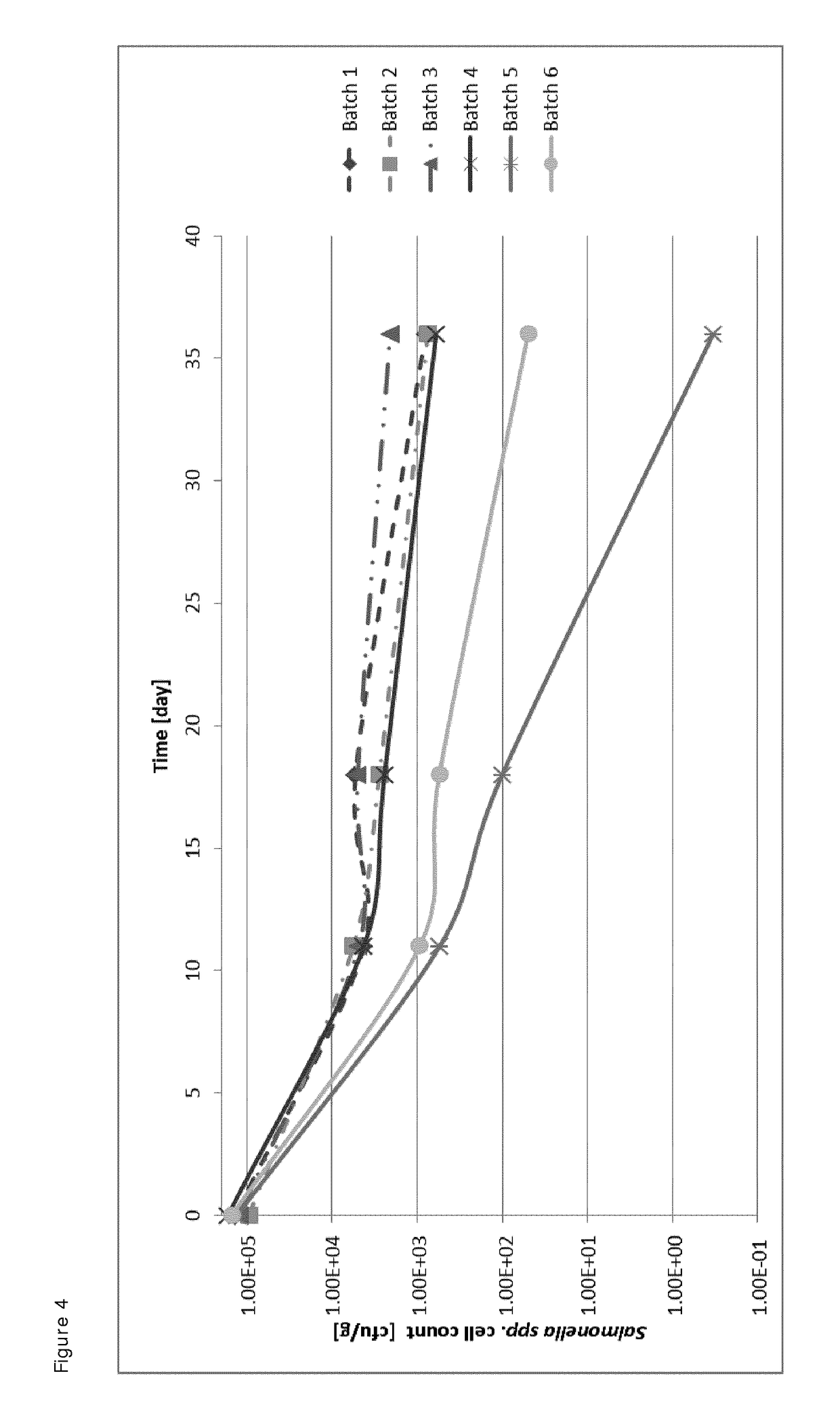Reduction of the concentration of gram-negative bacteria in a fermented food product by the combination of red wine extract and a culture comprising at least one bacteriocin-producing lactic acid bacterial strain
a technology of lactic acid bacteria and red wine extract, which is applied in the direction of lactobacillus, pediococcus, etc., can solve the problems of salmonella /i>, no effective anti-i>salmonella /i>solution is commercially available for raw fermented food applications
- Summary
- Abstract
- Description
- Claims
- Application Information
AI Technical Summary
Benefits of technology
Problems solved by technology
Method used
Image
Examples
example 1
Salmonella Challenge Test
[0064]The effect of a combination of a bacteriocin-producing culture and red wine extract towards Salmonella was shown in a challenge test which was performed according to the following description at appropriate facilities.
Materials and Methods:
[0065]A standard meat mince for grobe Teewurst (see exemplarily shown standard recipe) was supplemented with Staphylococcus xylosus (DSM 28308), Lactobacillus curvatus (DSM 18775) and Pediococcus acidilactici (DSM 25 28307) with a cell count concentration in a range of 1.0E+6 cfu / g to 1.0E+7 cfu / g of meat for each strain.
TABLE 1IngredientAddition [%]Total [kg]Gammon piece or silverside of pork5012,500Neck fat5012,500Meat base10025,000Dextrose0.350.088Pepper white0.200.050Paprika0.100.025Sodium ascorbate0.040.010Mace0.040.010Cardamom0.020.005Paprika extract0.010.003Nitrite curing salt (0.5%)2.400.600
[0066]The meat mince was subsequently inoculated by 5.0E+01 cfu / g of three different S. enterica subsp. typhimurium stra...
example 2
Bacteriocin Activity Test
[0077]The aim of this test is to quantitatively determine the activity of group IIa bacteriocins produced by a culture comprising at least one bacteriocin-producing lactic acid bacterial strain by using a rapid microtiter assay which is a modification and combination of the assays described by Budde et al., 2003.
[0078]It is generally recognized that group IIa bacteriocins inhibit Lactobacillus sakei NCFB 2714, hence this strain is often used as indicator organism in assays for detection of class IIa bacteriocins. The present microtiter assay gives a quantitative measure of the bacteriocin activity of class IIa bacteriocins expressed as Arbitrary Units (AU / ml) based on the number of two-fold dilutions of a culture supernatant causing 50% growth inhibition of the indicator organism Lactobacillus sakei NCFB 2714.
[0079]The culture fermentate of a culture comprising at least one lactic acid bacterial strain putatively producing a bacteriocin is prepared by inocul...
example 3
Salmonella Challenge Test in a Teewurst Meat Model System
[0083]The effect of a combination of two class IIa bacteriocin-producing cultures B-LC-20 (Pediococcus acidilactici) and F-LC (Staphylococcus xylosus, Pediococcus acidilactici, and Lactobacillus curvatus) and a red wine extract (RWE) towards Salmonella spp. in particular towards S. enterica serovar Typhimurium DSM11320 was tested in a challenge test performed in a meat model system based on a traditional “Teewurst” formulation. DSM11320 is a non-pathogenic S. enterica strain which is classified as risk class I according to TRBA 466 (“Technische Regeln für biologische Arbeitsstoffe”—“Einstufung von Prokaryonten (Bacteria and Archaea) in Risikogruppen”). The challenge test was performed according to the following description at appropriate facilities.
[0084]Materials and Methods:
[0085]A standard meat mince for “feine Teewurst” (see table 3) was produced according to the production process described (see table 4) and supplemented ...
PUM
 Login to View More
Login to View More Abstract
Description
Claims
Application Information
 Login to View More
Login to View More - R&D
- Intellectual Property
- Life Sciences
- Materials
- Tech Scout
- Unparalleled Data Quality
- Higher Quality Content
- 60% Fewer Hallucinations
Browse by: Latest US Patents, China's latest patents, Technical Efficacy Thesaurus, Application Domain, Technology Topic, Popular Technical Reports.
© 2025 PatSnap. All rights reserved.Legal|Privacy policy|Modern Slavery Act Transparency Statement|Sitemap|About US| Contact US: help@patsnap.com



